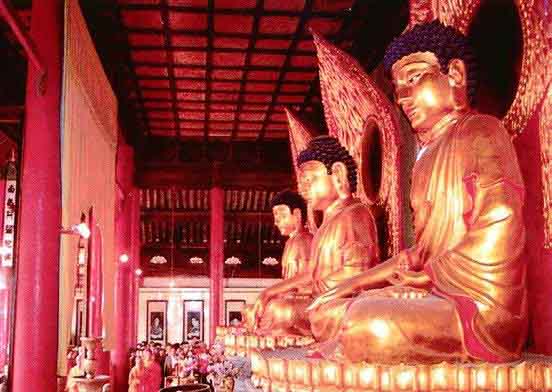| Legole.Com Discover china. Explore the beauty and wonder of the land, people, and culture of China. |
 |
|
|
 |
 It is one of the more famous Buddhist temples in China. The temple is located in the western section of Ziyou Street (Freedom Street) in the city. Earlier in the Northern and Southern Dynasties (420 - 589), the temple was built and called Xingjian Temple (Flourishing Establishment Temple). It was destroyed later during a war. In 711, a monk built a new one at the site and donated a three-meter-high Buddha statue. The emperor inscribed "Great Xiangguo Temple" on the plaque of the main hall, hence the name. The temple reached its splendor during the Tang and Song dynasties. It is a popular place where imperial families, Buddhist dignitaries and social celebrities gathered. Numerous activities including Buddhist ceremonies, festivities, ancestor worship were held in the temple. It is one of the more famous Buddhist temples in China. The temple is located in the western section of Ziyou Street (Freedom Street) in the city. Earlier in the Northern and Southern Dynasties (420 - 589), the temple was built and called Xingjian Temple (Flourishing Establishment Temple). It was destroyed later during a war. In 711, a monk built a new one at the site and donated a three-meter-high Buddha statue. The emperor inscribed "Great Xiangguo Temple" on the plaque of the main hall, hence the name. The temple reached its splendor during the Tang and Song dynasties. It is a popular place where imperial families, Buddhist dignitaries and social celebrities gathered. Numerous activities including Buddhist ceremonies, festivities, ancestor worship were held in the temple.
During the Tang Dynasty, China established a friendly relationship with Persia (today's Iran), Dashi (Arab nations) and Japan. At that time, Persian merchants, trading groups and Japanese Buddhist monks and students traveled a long way to Chang'an to visit Xiangguo Temple.
In the Song Dynasty, the temple was favored by the emperor and was expanded to a large scale with more buildings. It became the center of Buddhism and monks from India, Japan and Korea flock here to meet the Chinese emperor.
The Ming and Qing periods saw the decline of the temple. After 1949, it was restored by the Chinese government. Now the place has become a major tourist attraction because of its intact temple buildings and Buddha statues.
Like most of the Buddhist temples in China, the main axis consists of an arch gate, Devajara Hall (Hall of Heavenly Kings), Mahavira Hall (Daxiong Baodian), an octagonal glazed hall (Arhat Hall) and the Sutra-Keeping Hall. Side rooms flank the axis on each side. The whole complex features Qing-style architecture.
A wooden statue of a Bodhisattva carved out of a gingko trunk and found in the Arhat Hall is most impressive. The Bodhisattva has 1048 hands and on each hand is a small sacred eye. A group carving of five hundred Arhats is also attractive.
Admission Fee: 30
Opening Hours: 08:10 to 17:30
Recommended Time for a Visit: 40 minutes
Bus Route: 1, 20 |
 |
|
|
 |
|
